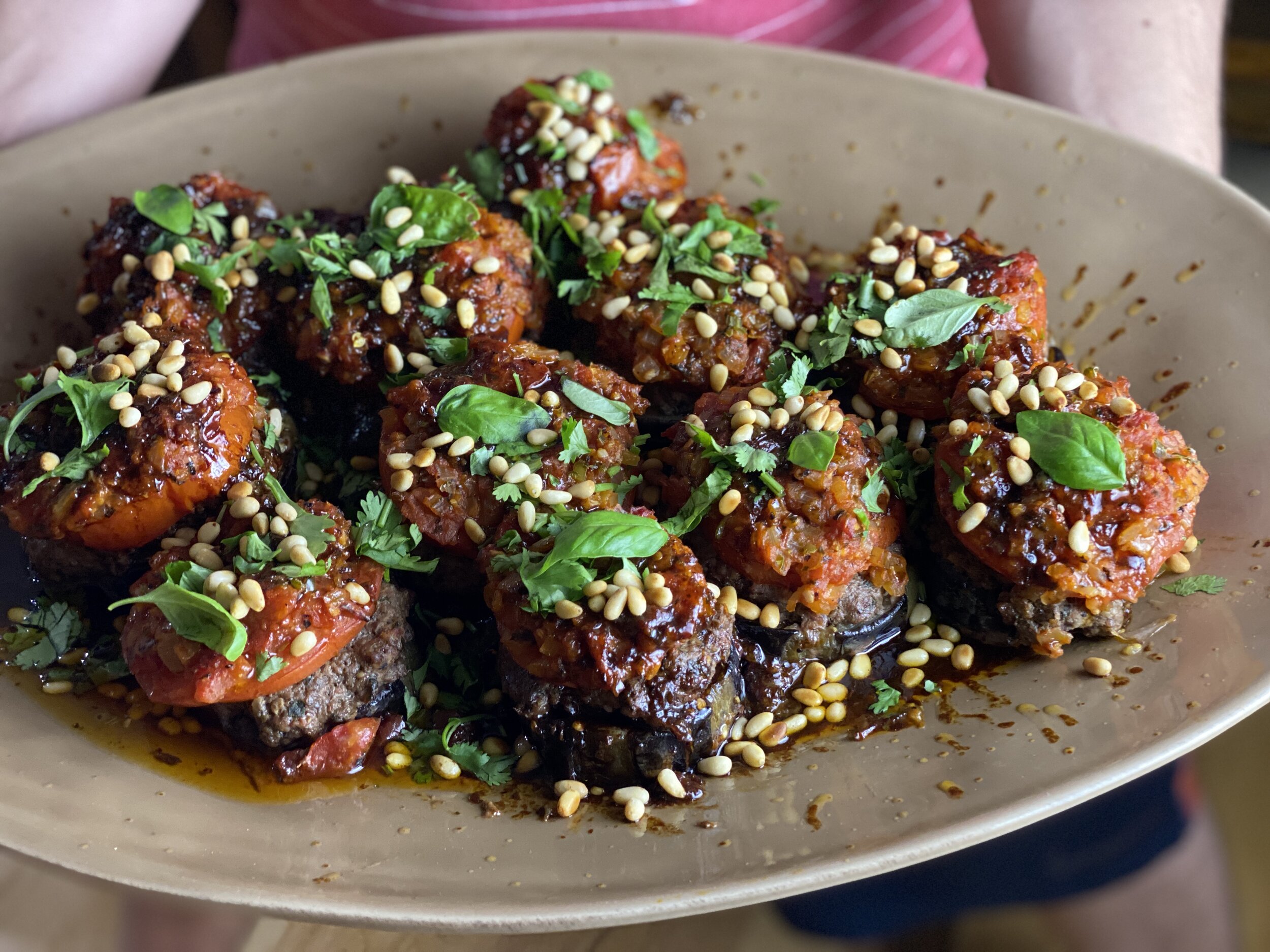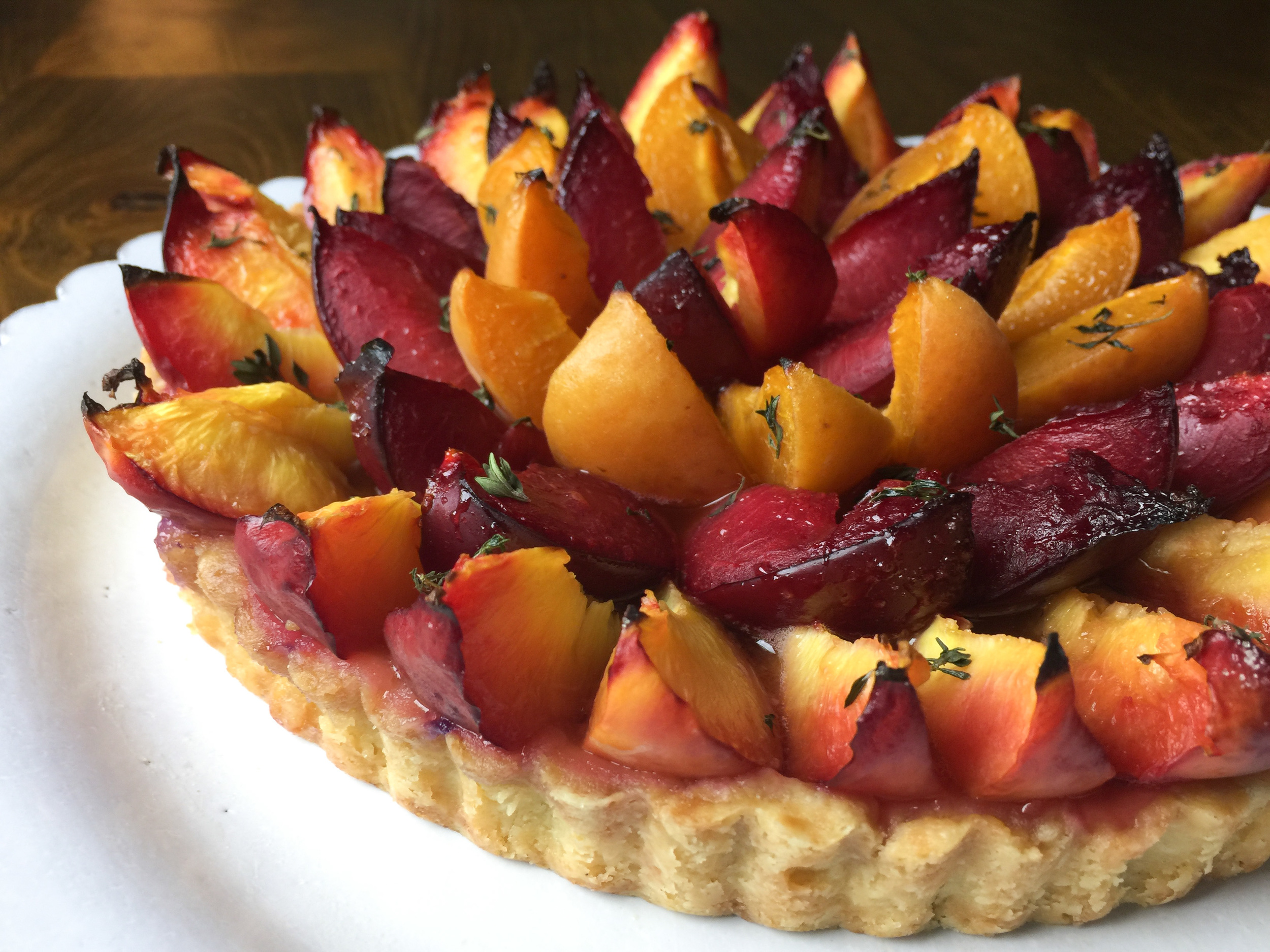Baked Kofta with Eggplant and Tomato from ‘Falastin’ by Sami Tamimi
By Leslie Brenner
No one ever craves eggplant. (Do they?!) And yet eggplant — or aubergine, as it’s more mellifluously called on the east side of the pond — is an integral part of so many enticing dishes. Here are eight recipes that push those big, shiny lunks into the realm of the irresistible.
‘Falastin’ Baked Kofta with Eggplant and Tomato
I fell in love with this recipe when I reviewed Falastin — Sami Tamimi and Tara Wigley’s wonderful 2020 cookbook featuring the foods and flavors of Palastine. Because the dish requires a fat slice of ripe tomato on top of each lamb-and-beef patty, it’s the perfect time of year to make it: that moment when tomatoes are still in high season and eggplants are starting to beckon. Where’s our star player? A substantial slice of meltingly roasted eggplant sits under each meat patty. Spiced tomato sauce goes on top, the whole thing is baked to lusciousness and topped with herbs and toasted pine nuts.
I made it again a few nights ago, and it was so good I nearly fainted.
A Magnificent Moussaka
If I had to choose only one way to eggplant for the rest of my days, it might well be this moussaka. Again, the eggplant consorts with lamb, tomato and spices — but in moussaka’s case it’s pulled together with rich, cheesy béchamel and a layer of potatoes. Our recipe, we venture to suggest, is hard to beat, which is why we call it Moussaka for the Ages.
Bring on the Baba Ganoush
Late-summer-into-fall is the perfect time to throw whole eggplants onto the coals of a Weber grill or (almost as good) in your broiler. After their almost unimaginable transformation to smoky, velvety unctuousness, stir in tahini whisked to fluffiness with lemon juice and season with garlic. Then swipe a warm pita bread through one of the world’s most spectacular dips.
Unreasonably Good Roasted Ratatouille
Traditional ratatouilles can be good (ish). Roast the vegetables to concentrate flavors and preserve textures, and it becomes outstanding. Now is prime season for all the relevant ingredients: Zucchini, bell peppers, tomato, and, you know, eggplant.
Anjali Pathak’s Charred Baby Eggplants
Cute little purple-and-white-striped fairy tale eggplants (shown below) are ideal for these outrageously good Charred Baby Eggplants from Anjali Pathak’s The Indian Family Kitchen. The eggplants are melty-soft and the coconutty, spicy topping — with dabs of yogurt and delicate curry leaves — turns them into something super special. Find the curry leaves in a well stocked Indian grocery or supermarket, if you’re lucky enough to have one handy.
Fairytale eggplants can sometimes be found in farmers markets or Indian groceries.
Zap ‘Em and Make ‘Em Dance!
Fairy tale or other baby eggplants are also perfect for the chef José Andrés’ crazy-delicious, umami-forward Dancing Eggplant, but everyday globe eggplants work great for this as well. Zap them in the microwave or grill them, slather them with a Japanese-inspired sauce and top with bonito flakes that seem to dance for an uncannily good snack or starter. We adapted it from Andrés’ 2019 book Vegetables Unleashed.
Tangy Eggplant Salad with a Creamy, Rich Tahini Swirl
This glorious dish from Reem Kassis’ The Arabesque Table would surely take top prize at a mezze potluck, if such a thing exists. Pomegranate molasses is responsible for the zing.
A Dreamy Eggplant-Lentil Situation from Ottolenghi
Eighth (but by no means least!) is this fabulous vegetarian main course from one of our favorite cookbooks, Ottolenghi Simple. Pretty little green lentils from France share the spotlight in the dish with melty, roasty eggplant and charred cherry tomatoes. Tangy yogurt adds cool creaminess, and fresh oregano makes it interesting. Perfect weeknight dinner material heading into the fall.
If you enjoyed this story, you might like:
“5 Favorite dishes for summer-into-fall”
“Exuberantly delicious and beautifully told, ‘Falastin’ is one of those life-changing cookbooks”
“This glorious plum-and-blackberry buckwheat tart is way easier than pie”
“Tomato love fest: Our favorite ways to celebrate ripe beauties at the height of their season”



























